I wish to create a 2D set of N points (typically 1e2 - 1e4) in a square with the following constraints:
there should be a minimal distance between all points (hard core exclusion zone)
the number of points filling the square is given in advance (or a close estimate), as I want to obtain a fixed density (I can adjust a little the size of the square afterwards if necessary).
the pattern should be reasonably "random"
a fast solution is preferred
I used rStrauss in the package spatstat before, but i could never figure out how to reliably obtain a given number of points, and quite often the function would stall my machine for 10 minutes, presumably because the task was too hard. I'm guessing there may be a more suitable function for this.
## regular grid of 1e2 points in [-10, 10]^2
xy = expand.grid(x=seq(-10, 10, length=10), y=seq(-10, 10, length=10))
N = NROW(xy)
EDIT: as suggested in the answer
xyr = rSSI(r=0.1, N, win = owin(c(-10,10),c(-10,10)), N)
plot(xyr)

